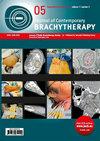近距离放射治疗中的增强现实技术:叙述性综述
IF 1.1
4区 医学
Q4 ONCOLOGY
引用次数: 0
摘要
近距离放射治疗(BRT)在肿瘤治疗中发挥着举足轻重的作用,可直接对患处进行精确的放射治疗。然而,这项技术需要大量的培训和技能开发,给广泛应用和确保患者安全带来了挑战。这篇叙述性综述探讨了增强现实(AR)在 BRT 中的应用,旨在总结现有证据,讨论主要发现、局限性和研究质量,并概述未来的研究方向。综述显示,在快速公交中整合 AR 的研究结果很有前景。研究表明,AR 在教育、培训、术中指导和治疗规划方面具有可行性和潜在优势。然而,证据仍然有限且不尽相同,大多数研究还处于初步阶段。标准化、前瞻性临床试验、以患者为中心的结果评估和成本效益分析成为未来研究的关键领域。增强现实技术通过提高精确度、安全性和训练效率,为 BRT 带来了变革性的潜力。要充分实现这些优势,该领域需要标准化方案、严格的临床试验和以患者为中心的深入调查。政策制定者和医疗服务提供者应密切关注 AR 的发展,并考虑其在临床实践中的应用、应急和有力的证据以及成本效益分析。积极追求循证实践将有助于优化 BRT 患者护理。本文章由计算机程序翻译,如有差异,请以英文原文为准。
Augmented reality in brachytherapy: A narrative review
Brachytherapy (BRT) plays a pivotal role in the treatment of tumors, offering precise radiation therapy directly to the affected area. However, this technique demands extensive training and skills development, posing challenges for widespread adoption and ensuring patient safety. This narrative review explored the utilization of augmented reality (AR) in BRT, seeking to summarize existing evidence, discuss key findings, limitations, and quality of research as well as outline future research directions. The review revealed promising findings regarding the integration of AR in BRT. Studies have suggested the feasibility and potential benefits of AR in education, training, intra-operative guidance, and treatment planning. However, the evidence remains limited and heterogeneous, with most studies in preliminary phases. Standardization, prospective clinical trials, patient-centered outcomes assessment, and cost-effectiveness analysis emerge as critical areas for future research. Augmented reality holds transformative potential for BRT by enhancing precision, safety, and training efficiency. To fully implement these benefits, the field requires standardized protocols, rigorous clinical trials, and in-depth patient-centered investigations. Policy-makers and healthcare providers should closely monitor developments in AR and consider its implementation in clinical practice, contingent and robust evidence, and cost-effectiveness analysis. The pro-active pursuit of evidence-based practices will contribute to optimizing patient care in BRT.
求助全文
通过发布文献求助,成功后即可免费获取论文全文。
去求助
来源期刊

Journal of Contemporary Brachytherapy
ONCOLOGY-RADIOLOGY, NUCLEAR MEDICINE & MEDICAL IMAGING
CiteScore
2.40
自引率
14.30%
发文量
54
审稿时长
16 weeks
期刊介绍:
The “Journal of Contemporary Brachytherapy” is an international and multidisciplinary journal that will publish papers of original research as well as reviews of articles. Main subjects of the journal include: clinical brachytherapy, combined modality treatment, advances in radiobiology, hyperthermia and tumour biology, as well as physical aspects relevant to brachytherapy, particularly in the field of imaging, dosimetry and radiation therapy planning. Original contributions will include experimental studies of combined modality treatment, tumor sensitization and normal tissue protection, molecular radiation biology, and clinical investigations of cancer treatment in brachytherapy. Another field of interest will be the educational part of the journal.
 求助内容:
求助内容: 应助结果提醒方式:
应助结果提醒方式:


